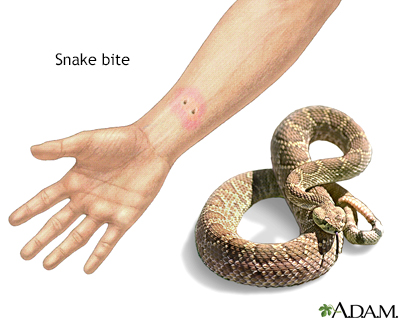Pregnancy SmartSiteTM
Wound - cut or puncture; Open wound; Laceration; Puncture wound DefinitionA cut is a break or opening in the skin. It is also called a laceration. A cut may be deep, smooth, or jagged. It may be near the surface of the skin, or deeper. A deep cut can affect tendons, muscles, ligaments, nerves, blood vessels, or bone. A puncture is a wound made by a pointed object such as a nail, knife, or sharp tooth. Puncture wounds often appear to be on the surface, but may extend into the deeper tissue layers. SymptomsSymptoms include:
Infection may occur with some cuts and puncture wounds. The following are more likely to become infected:
First AidIf the wound is bleeding severely, call 911 or the local emergency number. Minor cuts and puncture wounds can be treated at home. Prompt first aid can help prevent infection and thereby speed healing and reduce the amount of scarring. Take the following steps: FOR MINOR CUTS
FOR MINOR PUNCTURES
Do Not
When to Contact a Medical ProfessionalCall 911 or the local emergency number if:
Contact your health care provider right away if:
PreventionKeep knives, scissors, sharp objects, firearms, and fragile items out of the reach of children. When children are old enough, teach them to how to use knives, scissors, and other tools safely. Make sure you and your child are up to date on vaccinations. A tetanus vaccine is generally recommended every 10 years. ReferencesBall JW, Dains JE, Flynn JA, Solomon BS, Stewart RW, et al. Skin, hair, and nails. In: Ball JW, Dains JE, Flynn JA, Solomon BS, Stewart RW, eds. Seidel's Guide to Physical Examination. 10th ed. St Louis, MO: Elsevier; 2023:chap 9. Lammers RL, Aldy KN. Principles of wound management. In: Roberts JR, Custalow CB, Thomsen TW, eds. Roberts and Hedges' Clinical Procedures in Emergency Medicine and Acute Care. 7th ed. Philadelphia, PA: Elsevier; 2019:chap 34. Simon BC, Hern HG. Wound management principles. In: Walls RM, ed. Rosen's Emergency Medicine: Concepts and Clinical Practice. 10th ed. Philadelphia, PA: Elsevier; 2023:chap 52. | |
| |
Review Date: 11/2/2023 Reviewed By: Jesse Borke, MD, CPE, FAAEM, FACEP, Attending Physician at Kaiser Permanente, Orange County, CA. Also reviewed by David C. Dugdale, MD, Medical Director, Brenda Conaway, Editorial Director, and the A.D.A.M. Editorial team. The information provided herein should not be used during any medical emergency or for the diagnosis or treatment of any medical condition. A licensed medical professional should be consulted for diagnosis and treatment of any and all medical conditions. Links to other sites are provided for information only -- they do not constitute endorsements of those other sites. No warranty of any kind, either expressed or implied, is made as to the accuracy, reliability, timeliness, or correctness of any translations made by a third-party service of the information provided herein into any other language. © 1997- A.D.A.M., a business unit of Ebix, Inc. Any duplication or distribution of the information contained herein is strictly prohibited. | |

 First aid kit
First aid kit Laceration versus ...
Laceration versus ... Stitches
Stitches Snake bite
Snake bite
